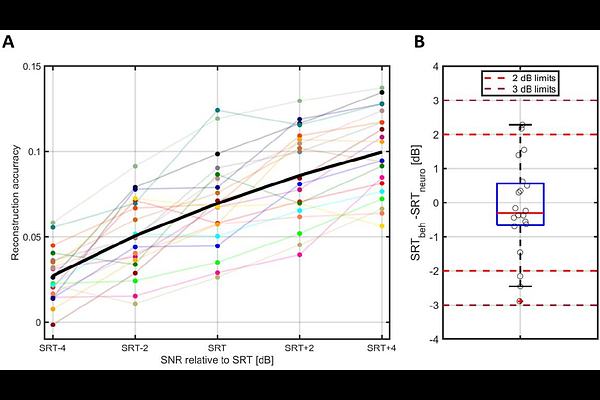Speech-reception-threshold estimation via EEG-based continuous speech envelope reconstruction

Speech-reception-threshold estimation via EEG-based continuous speech envelope reconstruction
Borges, H. B.; Zaar, J.; Alickovic, E.; Christensen, C. B.; Kidmose, P.
AbstractObjective: This study aims to investigate the potential of speech-reception-threshold (SRT) estimation through electroencephalography (EEG) based envelope reconstruction techniques with continuous speech stimuli. Additionally, we aim to investigate the influence of the stimuli signal-to-noise ratio (SNR) on the temporal response function (TRF). Methods: The analysis included data from twenty young normal-hearing participants, who listened to audiobook excerpts with varying background noise levels, while data were recorded from 66 scalp EEG electrodes. A linear decoder was trained to reconstruct the speech envelope from the EEG data. The reconstruction accuracy was calculated as the Pearson\'s correlation between the reconstructed envelope and the actual speech envelope. An SRT estimate (SRTneuro) was obtained as the midpoint of a sigmoid function fitted to the reconstruction accuracy-vs-SNR data. Additionally, the TRF was estimated at each SNR level, and a statistical analysis was conducted to reveal significant effects of SNR levels on the latencies and amplitudes of the most prominent components. Results: The behaviorally determined SRT (SRTbeh) ranged from -6.0 to -3.28 dB with a mean of -5.35 dB. The SRTneuro was within 2 dB from the SRTbeh for 15 out of 20 participants (75%) and within 3 dB from the SRTbeh for all participants (100%). The investigation of the TRFs showed that the latency of P2 decreased significantly and the magnitude of the N1 amplitude increased significantly with increasing SNR. Conclusion: The behavioral speech-reception-threshold (SRTbeh) of young normal-hearing listeners, can be accurately estimated based on EEG responses to continuous speech stimuli. In this study, the electrophysiological speech-reception-threshold (SRTneuro) measure was derived from a sigmoid fit to the envelope reconstruction accuracy vs SNR. The reconstruction accuracy of the envelope and the TRF features were all affected by changes in SNR, suggesting that the reconstruction accuracy of the envelope and the TRF features are related to the same underlying neural process.